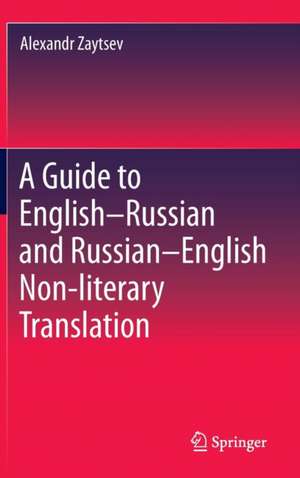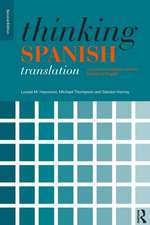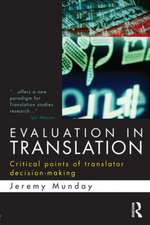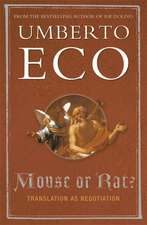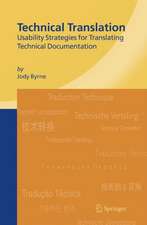A Guide to English–Russian and Russian–English Non-literary Translation
Autor Alexandr Zaytseven Limba Engleză Hardback – 15 iun 2016
| Toate formatele și edițiile | Preț | Express |
|---|---|---|
| Paperback (1) | 379.68 lei 6-8 săpt. | |
| Springer Nature Singapore – 7 iun 2018 | 379.68 lei 6-8 săpt. | |
| Hardback (1) | 386.81 lei 6-8 săpt. | |
| Springer Nature Singapore – 15 iun 2016 | 386.81 lei 6-8 săpt. |
Preț: 386.81 lei
Nou
Puncte Express: 580
Preț estimativ în valută:
74.02€ • 76.84$ • 61.72£
74.02€ • 76.84$ • 61.72£
Carte tipărită la comandă
Livrare economică 22 martie-05 aprilie
Preluare comenzi: 021 569.72.76
Specificații
ISBN-13: 9789811008429
ISBN-10: 9811008426
Pagini: 135
Ilustrații: VIII, 137 p. 2 illus., 1 illus. in color.
Dimensiuni: 155 x 235 x 10 mm
Greutate: 0.39 kg
Ediția:1st ed. 2016
Editura: Springer Nature Singapore
Colecția Springer
Locul publicării:Singapore, Singapore
ISBN-10: 9811008426
Pagini: 135
Ilustrații: VIII, 137 p. 2 illus., 1 illus. in color.
Dimensiuni: 155 x 235 x 10 mm
Greutate: 0.39 kg
Ediția:1st ed. 2016
Editura: Springer Nature Singapore
Colecția Springer
Locul publicării:Singapore, Singapore
Cuprins
PREFACE.- CHAPTER 1. TRANSLATION AND CHEESE.- CHAPTER 2. TYPES OF TRANSLATION: AN OVERVIEW.- §2.1. Types of translation summarized in a diagram.- §2.2. R. Jakobson’s approach.- §2.3. Machine translation vs. human translation.- §2.4. ‘Stylistic’ types of translation.- §2.5. ‘Psycholinguistic’ types of translation.- CHAPTER 3. WHAT IS IT THAT WE TRANSLATE? .- §3.1. The problem of terminology.- §3.2. The notion of ‘speech product’.- §3.3. Speech product as a complex communicative entity.- CHAPTER 4. WRITTEN TRANSLATION OF NON-LITERARY SPEECH PRODUCTS.- §4.1. Can you translate word-for-word?.- §4.2. The three stages in the process of translation.- CHAPTER 5. TEACHING AND STUDYING ENGLISH-RUSSIAN AND RUSSIAN-ENGLISH NON-LITERARY TRANSLATION.- §5.1. Notes to Educators.- §5.2. Notes to Trainees.- §5.3. Sample Assignments.- REFERENCES.
Notă biografică
Dr. Alexandr Zaytsev is a professional translator. He holds the position of Assistant Professor with the Department of Foreign Languages at the Sechenov First Moscow State Medical University (Moscow, Russia). He took his graduate training during 2003–2006 at the Moscow State Linguistic University, where he earned his PhD under Professor Vladimir Nayer. He has published over twenty articles and two monographs in the areas of Translation Studies and stylistics. Drawing on his extensive experience in the fields of scientific and technical translation, Dr. Zaytsev lectures on theory of translation, stylistics, and academic writing. He is a member of the European Society for Translation Studies.
Textul de pe ultima copertă
Lying at the intersection of translatology, cognitive science and linguistics, this brief provides a comprehensive framework for studying, investigating and teaching English-Russian/Russian-English non-literary translation. It provides a holistic perspective on the process of non-literary translation, illustrating each of its steps with carefully analyzed real-life examples. Readers will learn how to choose and process multidimensional attention units in original texts by activating different types of knowledge, as well as how to effectively devise target-language matches for them using various translation techniques. It is rounded out with handy and feasible recommendations on the structure and content of an undergraduate course in translation. The abundance of examples makes it suitable not only for use in the classroom, but also for independent study.
Caracteristici
Brings together relevant ideas developed by linguists, translatologists and cognitive scientists Describes three novel interconnected theories – that of speech products, that of knowledge types and that of translation techniques Includes a wealth of examples from English-Russian and Russian-English non-literary translations Includes supplementary material: sn.pub/extras
